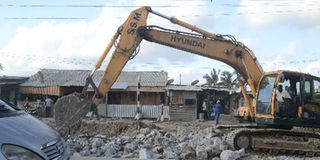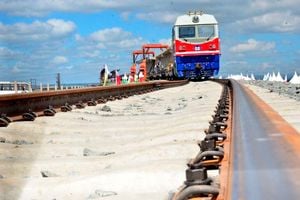Kenya unveils fresh road map for growth

Road construction works in Miritini, Mombasa. The World Bank has released over Sh54 billion to fund the laying of fibre-optic cable and the construction of a superhighway connecting Kenya and South Sudan. FILE PHOTO |
What you need to know:
- Ministry says it takes an investment of at least Sh50 billion every year to achieve the development objectives contained in Vision 2030
- According to the plan, the country will also seek to leverage on savings and credit societies and cooperatives to increase agro-processing firms in the country.
- Kenya’s cooperatives are seventh in the world and number one in Africa with estimated savings of Sh300 billion, constituting about 30 per cent of national wealth.
A road-map aimed at improving Kenya’s business environment has been launched.
The Ministry of Industrialisation and Enterprise strategy hopes to increase the portion of wealth generated by industries from the current 11 per cent to 20 per cent as well as boost exports from manufacturing to account for 30 per cent of country’s total exports.
At the moment, manufactured goods account for only 11 per cent of national industry wealth, with raw agricultural products constituting the bulk of it.
In the strategy released last week, the ministry said it takes an investment of at least Sh50 billion annually to achieve the industrialisation objectives meant to enable the country to attain a medium economic status in the next 17 years.
The ministry said it had identified key sectors where the country has an advantage over its competitors. They include steel, cement, construction, textile, leather, furniture, agriculture technology, ICT services, and other support industries.
“Since the 1990s, the country emphasised raising the level of exports and foreign exchange. This is the policy behind the Export Processing Zones, but the shift in government policy is to industrialise, which cannot focus on increasing exports alone,” said the Export Processing Zones Authority chairman, Mr Mathenge Wanderi.
According to the plan, the country will also seek to leverage on savings and credit societies and cooperatives to increase agro-processing firms in the country.
Kenya’s cooperatives are seventh in the world and number one in Africa with estimated savings of Sh300 billion, constituting about 30 per cent of national wealth.
The government plans to set up special economic zones and free trade areas as a way of increasing foreign direct investments, which have been declining compared to other countries in the East African Community.
Kenya attracted $400 million in 2012 compared to Tanzania with $1.6 billion.
THREE ZONES TO BE ESTABLISHED INITIALLY
Three zones located in Mombasa, Lamu, and Kisumu will initially be established before being set up in other parts of the country. A free port will be set up in Dongo Kundu between 2018 and 2020.
“Kenya should be the natural destination for overseas companies intending to open up new factories with the capacity to satisfy demand for the region and beyond,” the industrialisation policy document says.
Kenya sees opportunities in the $100 billion infrastructure development going on in East Africa and growing demand for food coupled with rise in formal retail business that has hit $3 billion in Kenya alone.
Some experts have, however, cautioned that issues involving provision of incentives selectively to companies set up in special zones could kill others established elsewhere.
There is also the possibility of violating the provisions of trade under the East African Community trading bloc.
“There should be details of additional benefits for establishment of free trade zones and special economic zones. As much as we want to encourage industries to set up, we should not kill other industries located elsewhere,” said Mr Gitau Githogo, an economist.
The recent discovery of oil, natural gas, coal, and other minerals has added impetus to the country’s intention to industrialise even as efforts to generate an additional 5000MW for the national grid to ensure adequate and affordable power in the next four years is stepped up.
Some selected industries like textile will be offered incentives through taxes. For example, there is a recommendation for used clothes to attract 10 per cent levy and new clothes 5 per cent to encourage growth of local apparels and fabrics.
Government agencies will be required to purchase homemade fabrics but such materials should have 75 per cent of local content as opposed to the current 30 per cent.
Others that will enjoy incentives are the leather industry, which has been growing since 2006 when the government introduced favourable policies to reverse its near-collapse brought about by liberalisation.
The cumulative benefit of investment in industries, according to the industrialisation road-map, is to create 10 million jobs by 2030.
Mr Mathenge said there were plans for counties to set up industrial parks that are expected to feed multinational companies with goods and services, leveraging on their strength in various areas.
He said EPZA pumped Sh18 billion into the economy through sourcing goods and services from local traders.
Small and medium enterprises will be assisted to provide backward linkages for the multinationals, spur growth, and create jobs.





